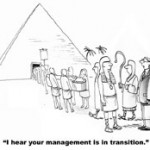 Change is rarely easy. Transitions in leadership fall into the change arena and not only is it rarely easy, a CEO transition, whether planned or unexpected, can lead to chaos if not handled with care. If there are extenuating circumstances around the transition, life can become an out of control roller coaster with a broken stop button. As with any other change, there are ways to prepare for eventualities and prevent catastrophes.
Change is rarely easy. Transitions in leadership fall into the change arena and not only is it rarely easy, a CEO transition, whether planned or unexpected, can lead to chaos if not handled with care. If there are extenuating circumstances around the transition, life can become an out of control roller coaster with a broken stop button. As with any other change, there are ways to prepare for eventualities and prevent catastrophes.
Succession Planning: Succession planning plays a large role and this responsibility falls squarely on the shoulder’s of the Board and the current CEO – unless, of course, the current CEO is going to be asked to leave prematurely. The problem is that Boards meet, at the most, monthly. Some organizational Boards meet even more infrequently. Therefore, succession planning should be on the agenda at every Board meeting. Some organizations select a hiring committee to aid in the search as well. An outside adviser or consultant can aid in the process as well. Spending a lot of time on the selection of the next CEO does not guarantee success. There are a lot of companies that make the transition successful spending little time in the effort. However, there are certain elements and processes that help every executive transition flow better.
Assessment Process: A third party to administer assessments to candidates is a must. No assessments are perfect and neither is any CEO candidate nor will h/she be perfect when sitting in the CEO chair. The trick is to find the gaps between the CEO’s skills and attributes and what the organization needs to move it forward. Look at the assessment results, interview data, and reference feedback and see what the candidate lacks that can be developed. It might be even more important to determine if the candidate is aware of his/her strengths and weaknesses and how one plans to close the gap. If you are interviewing a candidate who is either unaware of weaknesses, fails to admit weaknesses, or is in denial about having weaknesses, usher the candidate out politely and scream, “Next!!”
Hiring to Maintain the Status Quo: Seriously? Even though the company may be operating smoothly, it must be prepared for changing trends, changing competition, the changes the competition makes, and market shenanigans. Can you say ‘08? Otherwise, change will run the company over like it was hit by a freight train and unlike cartoon characters, who spring back to life, it may never recover. This has to do with the next – or maybe first – key consideration below.
Future Business Strategy: Be prepared to analyze what is and is not currently working. Revisit strategic long-range goals, operating systems, finances, organizational dynamics, including the culture, and the state of the industry. Will the candidate fit into the organizational culture or does the culture need to change to meet market demands and if it does need to change, is the candidate under consideration up to the job?
Administrative Aspects: Remember, there are still the seemingly mundane tasks such as the search itself and, if the new CEO, is an “outsider” he or she will need to go through a certain amount of assimilation. Don’t forget the communication process that must take place both within and outside of the organization surrounding the change including that between senior managers and the Board.
Teambuilding: This task is often neglected. Conducting teambuilding such as our (shameless plug here) Tandem Team X-Ray Program can go a long way in enhancing communication, understanding, kicking off productivity, and facilitating the change on a number of levels. Whether you use our program or another, teambuilding is a major tool that will save a lot of both short and long-term headaches.
Another tip is to make sure that your HR is familiar with what does and what doesn’t contribute to the success of succession planning. Don’t make the mistake of thinking that once the transition is complete that the transition process is over. It ends when those in places of influence are following the new leader. The Board doesn’t have to be recruiting or development gap experts. They do, however, need to know what questions to ask, create and be involved in a stable process, and be knowledgeable of each candidate under serious consideration.
While there is no magic process, frequent communication, anchoring key decisions, and involving other relevant individuals and committees, and (when possible) involving the current CEO are all elements that seem to be staples to consider in this all important transitional process.
Graphic Credit BigStock.com








